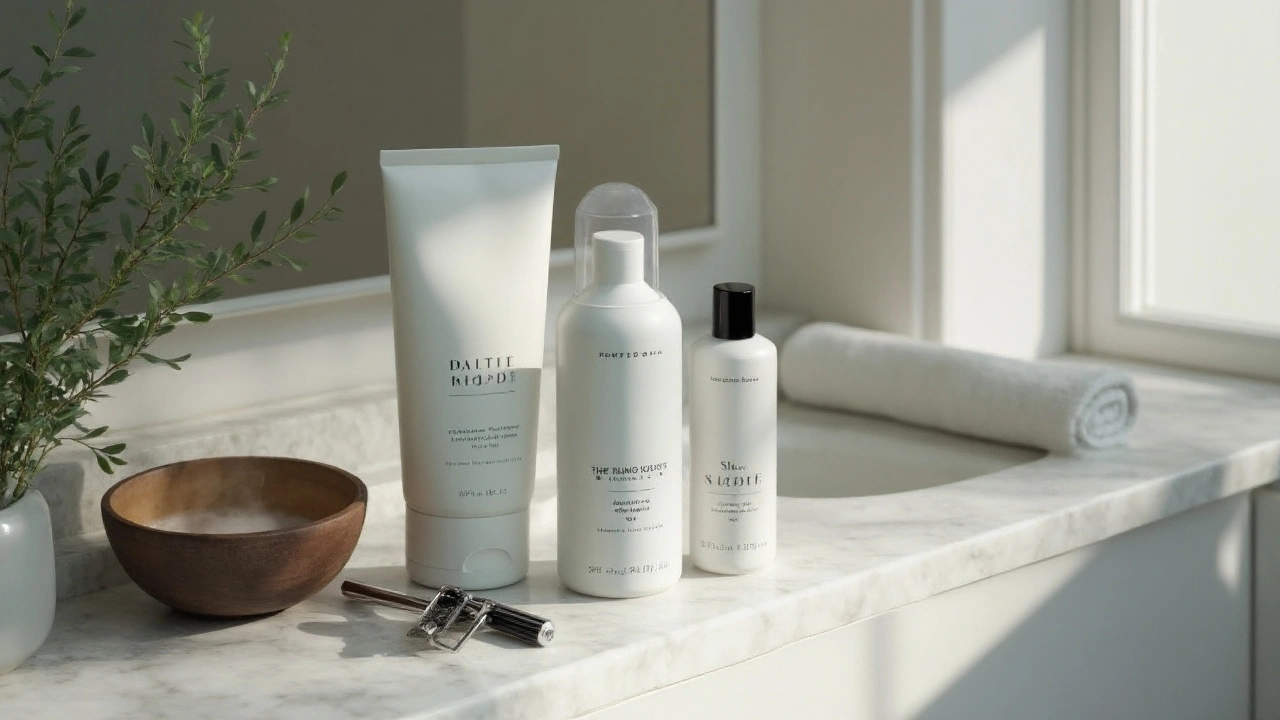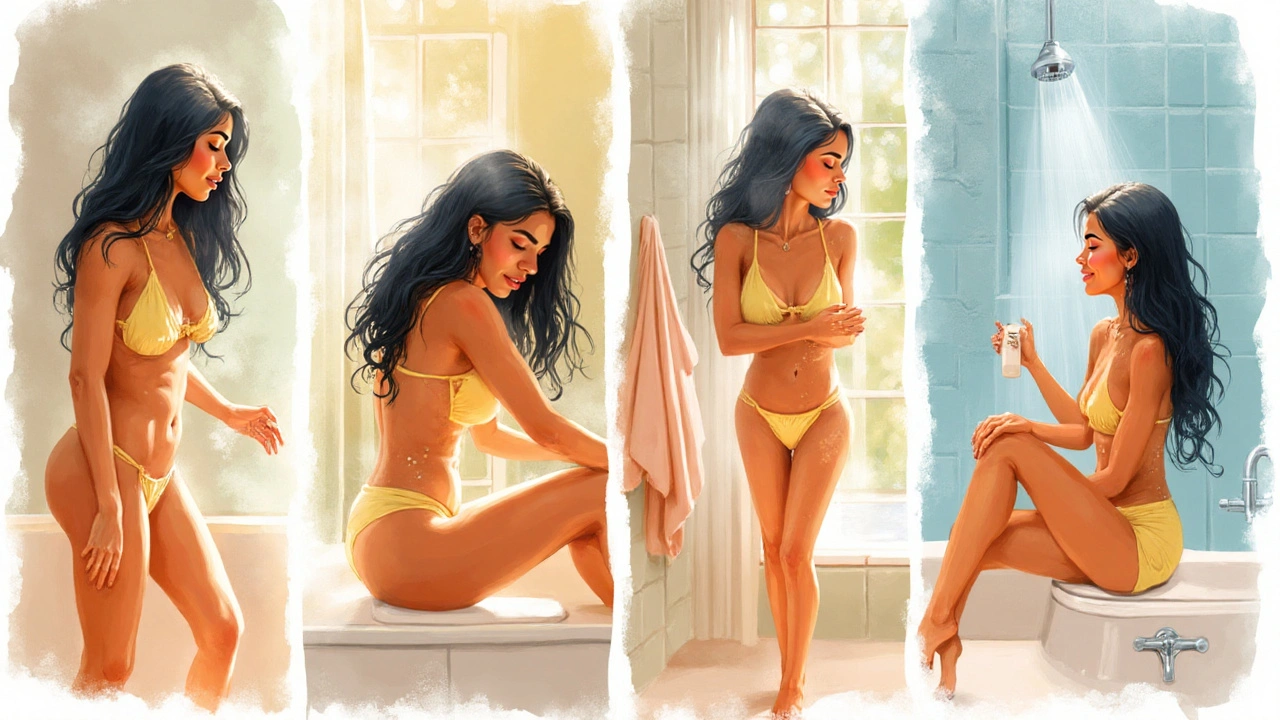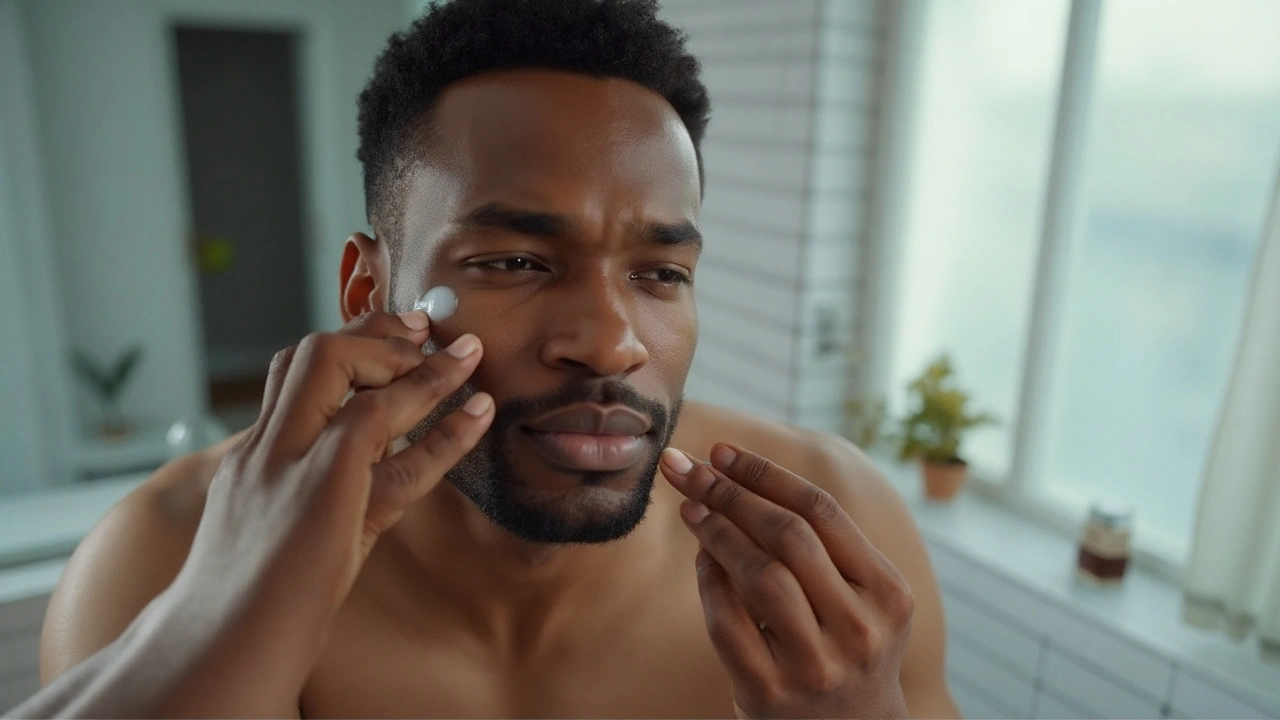Razor burn shouldn’t hijack your day. The sting, the redness, the bumps-none of it is fun, and all of it can be avoided or fixed. Allantoin is one of those quiet, reliable ingredients that takes the heat out of shaving. It won’t numb your face or legs. It just helps your skin act like a well-behaved barrier again. If you want quick relief now and fewer flare-ups later, this is your playbook.
- TL;DR
- Allantoin is a skin protectant and mild keratolytic that reduces sting, redness, and roughness from shaving without clogging pores.
- Use 0.5-1% allantoin in an alcohol-free balm right after shaving; pair with niacinamide or panthenol for extra calm.
- For prevention: hydrate, soften hair, use a sharp 1-2 blade razor, shave with the grain, rinse cool, then apply allantoin.
- If bumps look like ingrowns (pseudofolliculitis), add a low-strength exfoliant a few nights a week and still keep allantoin daily.
- Evidence is strongest for general soothing and barrier support; it’s safe for sensitive skin and daily use.
Why allantoin works for razor burn (and when it shines)
Razor burn is irritant contact dermatitis from friction, a blunt or dirty blade, heat, or harsh formulas. If your skin stings for hours after a shave and looks patchy red, that’s classic razor burn. If you get tender, trapped hairs-especially on the neck, bikini line, or anywhere hair is curly-that’s pseudofolliculitis barbae (ingrowns). Allantoin helps both, but in different ways.
What is allantoin? It’s a small molecule that shows up in many plants and is also made in labs for skincare. It’s a United States OTC skin protectant active-the same group that includes petrolatum and colloidal oatmeal-under the FDA Skin Protectant Monograph (21 CFR 347). That monograph allows 0.5-2% allantoin in leave-on products. The Cosmetic Ingredient Review Expert Panel has assessed allantoin as safe as used in cosmetics, with common leave-on use levels up to 2%. Translation: it’s legit, it’s gentle, and it’s widely accepted.
How does it calm a shave flare? Three actions matter here:
- Barrier protectant: it forms a light, breathable shield that reduces water loss and friction. That means less sting and faster comfort.
- Mild keratolytic: it helps loosen and smooth dead skin, which stops razor “drag” and reduces clogged hair openings that lead to ingrowns.
- Pro-healing support: lab and animal models show it supports new epithelial growth and reduces roughness. Human trials are fewer, but derm texts and decades of use back up its soothing role.
What it won’t do: it won’t act like a steroid, and it won’t dissolve deep ingrowns overnight. That’s okay-you don’t need a sledgehammer for a squeaky hinge. Allantoin takes the edge off fast and sets up your skin to recover cleanly.
Who benefits most?
- Sensitive or reactive skin that can’t handle strong acids or menthol-heavy aftershaves.
- Curly, coarse hair types prone to ingrowns (neck, jawline, bikini line, back of thighs).
- Anyone shaving in hot, dry weather or hard water. Here in Perth, summer showers and quick gym shaves are a recipe for flare-ups-this is where allantoin earns its keep.
Evidence snapshot you can trust:
- FDA OTC monograph: lists allantoin (0.5-2%) as a skin protectant active for minor skin irritation.
- Cosmetic Ingredient Review (2015 safety assessment): supports safe use, typically up to 2% in leave-ons.
- Dermatology guidance on razor burn and pseudofolliculitis (American Academy of Dermatology): focus on reducing friction and irritation, using alcohol-free, fragrance-free post-shave care-roles where allantoin fits well.
Bottom line: the best part isn’t only the relief. It’s the prevention. When you add allantoin to a smarter shave routine, you’re less likely to flare in the first place.

How to prevent and treat razor burn with allantoin (step-by-step, for face, legs, and bikini)
Here’s a simple, repeatable routine. Keep it boring and consistent, and your skin will do the rest.
Pre-shave (1-2 minutes):
- Soften hair: rinse with warm water for 60-90 seconds or shave after a shower. If you’re short on time, lay a warm, damp washcloth for one minute.
- Slip, not foam: use a gentle cream or gel with glycerin. Skip strong fragrance, menthol, eucalyptus, or high alcohol. Bonus if it lists allantoin, panthenol, or colloidal oatmeal.
- Check your blade: if it tugs, bin it. Rule of thumb: switch every 5-7 face shaves or 3-5 leg/bikini shaves.
During shave:
- Use short strokes and light pressure. Let the blade do the work.
- Shave with the grain first. Across the grain only if needed, and avoid against the grain on inflamed areas.
- Rinse the blade in hot water after every pass; don’t tap it on the sink (that damages the edge).
Post-shave (the critical minute):
- Rinse cool to close down that brief inflammatory window.
- Pat dry-don’t rub.
- Apply an alcohol-free balm or lotion with 0.5-1% allantoin while skin is still slightly damp. Aim for a pea-size on the face, a grape-size per leg.
- Optional boosters: 2-4% niacinamide or 1-2% panthenol for extra barrier support. If you’re acne-prone, pick non-comedogenic formulas.
Night routine if you get bumps:
- Two to three nights a week, use a mild chemical exfoliant on non-shave nights-think 1-2% salicylic acid or 5-8% glycolic on the legs/neck. Keep it light. Follow with your allantoin balm.
- Persistent ingrowns? Dab a thin layer of 5-10% azelaic acid on the trouble spots at night. It’s friendly with allantoin.
Morning-after care:
- If you still feel heat, reapply a thin layer of your allantoin balm.
- Hold the razor for 24-48 hours if the area is red and tender. Shaving over irritation extends the flare.
Dosing cheat sheet:
- Look for 0.5-1% listed on the label or INCI list near the actives. If the brand doesn’t list a percentage, you can still test it-good balms will calm sting within 5-10 minutes.
- Apply up to twice daily on shave days; once daily on rest days for prevention.
Ingredient combos that play well with allantoin:
- Niacinamide (2-5%): reduces redness and strengthens barrier.
- Panthenol (1-2%): adds hydration and calm.
- Aloe vera, colloidal oatmeal: extra soothing.
- Low-dose salicylic acid (0.5-1% leave-on): for ingrowns; use on non-shave nights.
What to avoid right after shaving:
- Denatured alcohol or high-ethanol aftershaves (they sting and delay barrier repair).
- Heavy fragrance, menthol, eucalyptus, peppermint (cooling now, cranky later).
- High-strength acids or retinoids on the same night (save those for non-shave nights if you tolerate them).
Real-life scenarios:
- Cloudy red patches on the neck after a fast morning shave: shift to a single- or double-blade razor, don’t go against the grain, and apply a 0.5-1% allantoin balm. Do this for one week; you should see fewer hot spots by day three.
- Legs with little itchy dots after shaving: switch to a creamier shave gel, change blades more often, and layer allantoin balm while skin is damp. Add a 5% glycolic lotion two nights a week for smoother glide.
- Bikini-line ingrowns before the beach: trim hair shorter before shaving, use a guard on a single blade, shave with the grain only, then allantoin balm. Spot-treat ingrowns with 1% salicylic acid on off nights.
Quick test for product fit: if it stings more than 10 seconds or you see more redness in 30 minutes, it’s not the right formula for you. Swap to a simpler, fragrance-free balm with allantoin and panthenol.
And yes, if you were googling this at 6 a.m. because your neck is on fire: apply a thin layer now. Take a cool cloth for one minute. You’ll be presentable by your first meeting.

Quick tools: comparisons, checklists, FAQs, and troubleshooting
Here’s how allantoin stacks up to common post-shave ingredients, so you can pick what fits your skin and your routine.
| Ingredient | Main role | Typical strength | Evidence for razor burn | Irritation risk | Best use |
|---|---|---|---|---|---|
| Allantoin | Skin protectant, mild keratolytic | 0.5-1% (up to 2%) | Good supportive evidence; FDA-listed skin protectant; long safe use | Low | Daily post-shave, sensitive skin |
| Hydrocortisone (OTC) | Anti-inflammatory steroid | 0.5-1% | Strong for short-term flare control | Moderate if overused (thinning) | Short bursts (1-3 days) for severe flares |
| Aloe vera | Soothing, cooling | As extract/gel | Supportive for irritation | Low | Stacks well with allantoin |
| Colloidal oatmeal | Anti-itch, barrier support | 0.1-1% | Good for itch and redness | Low | Dry, itchy razor burn |
| Niacinamide | Redness reduction, barrier repair | 2-5% | Good for redness and uneven tone | Low-moderate (rare flush) | Daily support, discoloration |
| Witch hazel (alcohol-free) | Mild astringent | Varies | Mixed; can feel soothing | Low-moderate if alcohol present | Use only alcohol-free versions |
| Salicylic acid | Exfoliant, anti-ingrown | 0.5-2% | Good for ingrowns (PFB) | Moderate if overused | Non-shave nights on bump-prone areas |
Fast checklist (print or screenshot):
- Before: warm water soften (60-90 sec), slick shave cream/gel, sharp blade.
- During: light pressure, with the grain first, rinse blade every pass.
- After: cool rinse, pat dry, apply 0.5-1% allantoin balm on damp skin.
- Prevention: change blades often; two nights a week use a gentle exfoliant for ingrowns.
- Avoid: alcohol-heavy aftershave, fragrance, menthol right after shaving.
Decision helper-what are you dealing with?
- Red, burning patches right after shaving → irritant razor burn. Treat with allantoin balm now; pause shaving 24-48 hours.
- Small, tender bumps 1-2 days later, often with a hair trapped → ingrowns (pseudofolliculitis). Add salicylic or glycolic on non-shave nights, keep allantoin daily.
- Clusters of pus-filled bumps that spread → possible bacterial folliculitis. Use clean blades, avoid sharing razors; see your GP if it worsens-may need an antibacterial wash or topical.
Pro tips you’ll actually use:
- Shave at night before a big day. Skin has hours to settle under your allantoin balm while you sleep.
- Use a single- or double-blade razor if you’re prone to ingrowns; multi-blade razors lift and cut below the surface.
- Hard water or gym showers? Add a slicker shave gel and don’t rush the rinse-you need that glide.
- Don’t chase glass-smooth on trouble zones. One gentle pass beats three angry ones.
Safety and compatibility:
- Non-comedogenic: allantoin doesn’t clog pores.
- Pregnancy and breastfeeding: generally considered safe in cosmetics; stick to typical 0.5-2% leave-on products and avoid broken skin. If in doubt, ask your clinician.
- Plays well with retinoids and vitamin C if you separate them from the immediate post-shave window. Keep the first hour after shaving calm.
What to buy (label-reading tips):
- Look for “allantoin” in the first half of the ingredient list. If a product states the percentage, 0.5-1% is the sweet spot for daily use.
- Skip formulas that list “Alcohol Denat.” in the top five ingredients for post-shave use.
- For legs and body, lotions pump and spread easier than thick creams-less rubbing on fresh skin.
Common mistakes to avoid:
- Using a face scrub in the shower and then shaving right away. That’s double irritation. If you like scrubs, use them on non-shave days.
- Pressing harder when a blade is dull. Swap the blade; pressure multiplies micro-cuts.
- Going against the grain on day-one regrowth. That’s asking for ingrowns.
Mini‑FAQ
- Does allantoin work instantly? You should feel sting drop within minutes; redness often looks calmer within 30-60 minutes. Deep bumps take longer.
- Can I use it with salicylic acid? Yes-use salicylic on non-shave nights and allantoin morning and night.
- Is 2% better than 1%? Not always. Many people do great at 0.5-1%. Higher isn’t guaranteed to feel better.
- Will it fade dark marks from old ingrowns? Not by itself. Pair daily allantoin with niacinamide or azelaic acid to help even tone.
- Can I use it every day? Yes. It’s designed for frequent use.
Troubleshooting by scenario
- “My neck stays red no matter what.” Try a single- or double-blade safety razor, drop against-the-grain passes, and apply an alcohol-free allantoin balm right after shaving. If still red after a week, take a 3-5 day shaving break and use the balm twice daily.
- “Ingrowns on the bikini line keep coming back.” Trim hair to 3-5 mm before shaving, shave with the grain only, and use 0.5-1% salicylic two nights a week plus your allantoin balm daily. Wear breathable fabrics; friction matters.
- “Aftershaves burn my face.” Switch to a fragrance-free balm with allantoin, panthenol, and niacinamide. If you like a ‘fresh’ feel, cool the balm in the fridge-no menthol needed.
- “I nick myself often.” Slow down, use a thicker gel, and keep skin taut with short strokes. Post-shave, dab a styptic on cuts, then apply your allantoin balm around-not directly into-fresh cuts.
- “I have acne and shave daily.” Use a gentle shave gel, a sharp blade, and apply allantoin balm after. Keep benzoyl peroxide or retinoids for non-shave nights or at least one hour after shaving.
When to escalate care
- If redness, pain, or pus persists beyond 3-5 days despite gentle care, see a clinician. You may need a short course of topical steroid, antibacterial wash, or a different hair removal plan.
- If you get keloid-like raised scars from shaving, ask about alternative methods (electric clippers with a guard, depilatory creams you tolerate, or laser). Keep allantoin as your calm-down step either way.
What to remember: the right routine does most of the heavy lifting; the right ingredient seals the deal. Keep your strokes light, your blade sharp, your skin damp when you apply, and let allantoin for razor burn do its quiet, steady work.
